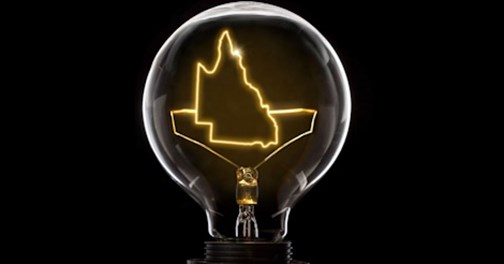A new report by independent public interest think tank Climate Energy Finance (CEF) finds that Queensland’s nation-leading investment into transmission, large-scale, low-cost renewable energy and Consumer Energy Resources (CER) is crowding-in a tidal wave of both public and private capital. Leveraging Queensland’s game-changing $62bn Energy and Jobs Plan, this is turbocharging the state’s energy transition, reducing reliance on expensive, polluting fossil fuels and putting downward pressure on household and commercial energy bills.

This is also creating an equitable opportunity for regional Queenslanders to be part of the energy transition as Queensland pivots to embrace its economic future as a zero-emissions energy, employment, trade and investment leader. QLD is now at the precipice of transforming from a legacy coal and gas petrostate to a clean tech superpower in the value-added critical minerals and green hydrogen key to global decarbonisation.
The report, ‘Queensland’s Energy Transformation: From Coal Colossus to Renewable Energy Superpower’ finds:
- With renewables the fastest growing energy sources in QLD’s grid, the coal colossus of old is in terminal decline and the state is on track for its coal fleet to retire in just over one decade, by financial year (FY) 2035.
- QLD is on track to deliver its renewables targets as clean energy replaces coal. It has legislated 70% renewables by 2032 and 80% by 2035, earmarking 25 gigawatts (GW) of zero-emissions generation – a massive 40% of the total current National Electricity Market (NEM). This month, the Government introduced a bill to legislate a 75% emissions reduction by 2035 and net zero by 2050, complementing its renewables ambitions.
- A public and private capital tidal wave is driving the energy transition in the state:
- The 25GW target capacity would result in over $45 billion (bn) of investment into large-scale clean energy generation, of which $21bn will be from private capital, ensuring majority public market share.
- Through the QLD government’s Energy and Jobs Plan, $19bn will be allocated from the QLD budget over 4 years.
- The Australian Energy Market Operator (AEMO) identifies 41GW of utility scale wind and solar in the investment pipeline for QLD. This represents over $73bn of investment proposals from private developers.
- The QLD Government is expected to invest $10.4bn into transmission projects.
- CopperString – a $5bn QLD government investment into a ~1000km high-voltage transmission highway connecting far north and west regional QLD – will enable large-scale renewable projects to deliver low-cost energy to Queenslanders and industry, driving decarbonisation as it facilitates isolated communities to invest in grid-connected rooftop solar and batteries. It is key to QLD’s industrial transformation into a zero-emissions powerhouse, unlocking the 375,000km2 North West Minerals Province, one of the world’s richest deposits of critical minerals (est. value $500bn).
- Alongside utility-scale firmed renewables and transmission, Consumer Energy Resources such rooftop solar, batteries, EV and heat pumps are a key to the energy solution – fastest to deploy, scalable and cost-competitive. QLD leads the way globally with the world’s highest penetration of rooftop solar. Regulatory and capital barriers need to be overcome to incentivise uptake, via programs like the new Battery Booster rebate.
- Firmed renewables are the cheapest form of energy, even ignoring carbon costs that must inevitably be priced in. The price for rooftop solar in Queensland has halved in the past decade, as lithium-ion cells for batteries have seen cost falls of > 90%. Reduced exposure to fossil fuel prices and increased renewables penetration has seen QLD wholesale electricity prices drop 38% to $79/megawatt hour in fourth quarter 2023.
- Queensland’s transformation has wider implications for national transition:
- The decarbonisation of Queensland’s energy grid is a key enabler of national emissions reduction and renewables targets, including Energy Minister Chris Bowen’s ambitious 82% renewables by 2030 target, and beyond.
- QLD is a case study of how ambitious government decarbonisation policy and public capital investment accelerates transition. The onus is now on the Federal government to increase the ambition of its decarbonisation policy and investment settings and the private capital will flow, at massive scale.
Leading energy analyst Tim Buckley, director of CEF and report co-author said:
“QLD has leveraged the multibillion dollar revenue bonanza reaped from progressive coal royalties during a period of coal price hyperinflation to reinvest in public infrastructure to enable the state’s decarbonisation. This is good public policy.
While neither Queensland’s pumped hydro storage nor CopperString projects are commercially viable in isolation, the government’s investment is an enabler of massive follow-on investment, signalling political confidence and policy certainty to investors, accelerating momentum, and underwriting the transformation.
This in turn will enable massive investments in zero-emissions future industries, such as critical minerals, driving exports, regional employment and investment, as a flood of firmed renewables slashes industrial and residential energy bills.
Underpinning this is the core value of avoiding the environmental and financial costs of fossil-fuel driven climate change – costs ‘socialised’ onto all in the form of massive floods, increasing insurance premiums and uninsurability. Decarbonisation is the solution to these climate-related crises.
The wider lesson is for the Federal government and state counterparts to share this vision and ambition. We are headed at last in the right direction, and it’s time to accelerate. Economies the world over are rapidly decarbonising. Global leader, China, is greening its economy at a staggering pace and the US government is investing US$1 trillion in the Inflation Reduction Act’s “green new deal”, now driving massive deployment of renewables, jobs and GDP growth.
Australia should take a lead from Queensland and its global partners and act now with a landmark, nation-building strategic investment of public capital into the Future Fund, to leverage existing investments in the National Reconstruction Fund and Rewiring the Nation. We need the government to underwrite local procurement policies to underpin domestic manufacturing.
CEF urges the government to commit another $100bn in the May Federal Budget. This would unleash hundreds of billions in private capital and accelerate nationwide decarbonisation commensurate with the scale of our opportunity to lead the world in cheap firmed renewables and dominate the market in energy transition materials such as value-added critical minerals.
Supporting the report’s findings, Simon Corbell, chair and CEO of the Clean Energy Investor Group, representing renewable energy investors with ~11GW of installed capacity across ~70 power stations and a portfolio value of ~$24bn, said:
“As CEF highlights, Queensland is on track to deliver its $62bn transformational Energy and Jobs Plan paving the way for significant opportunities for private capital to invest in renewable energy projects to decarbonise the state’s electricity supply.
The clarity provided to investors throughout the plan creates a strong market signal and lays the foundation for further private investment in export scale projects which would unlock the full potential of Queensland’s development pipeline.”
Matt Pollard, CEF analyst and report lead author said:
“Queensland has a significant competitive advantage in scaling CER as a key solution to address the climate, cost of living and energy price crises, as its global leadership in rooftop solar remains a primary driver for increasing renewables penetration across the state.
The Queensland Government is now accelerating CER deployment by minimising capital barriers with its new Battery Booster program, providing rebates of up to $4,000 for battery storage systems, putting lasting downward pressure on electricity bills. This complements the billions it is investing in utility-scale firmed solar, wind and transmission to transform the grid, as it crowds-in a huge influx of private capital.
With Queensland announcing last week that it has raised its climate ambition to a 75% emissions reduction target by 2035, alongside its 80% renewables by 2035 target, it has effectively demonstrated the power of aligning climate objectives and public financing in accelerating the energy transition for the permanent benefit of all Queenslanders.”


